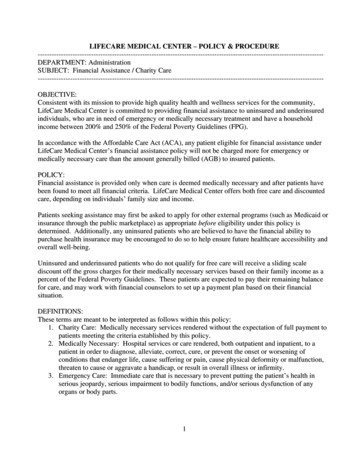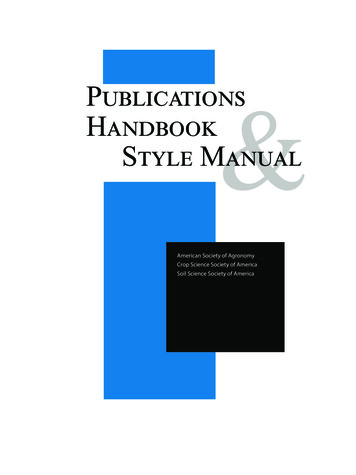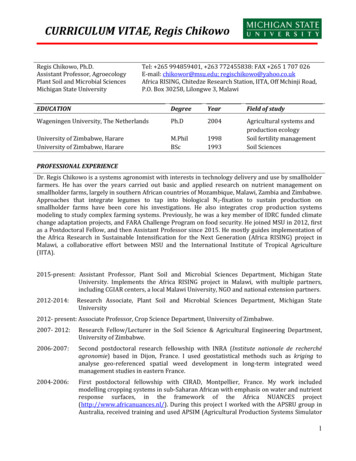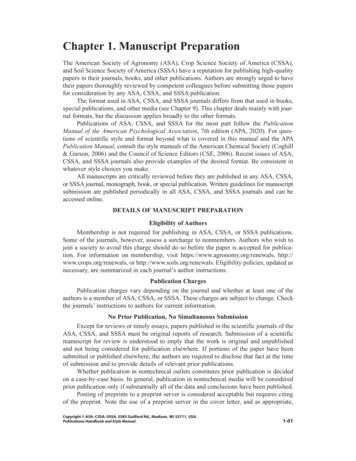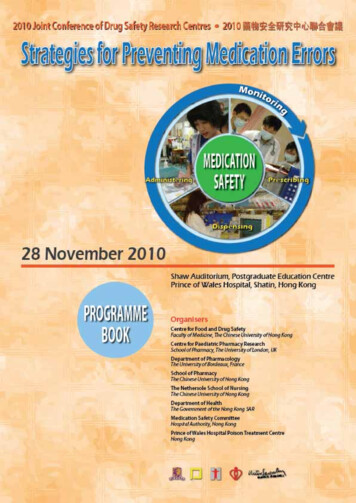
Transcription
1Joint Conference of Drug Safety Research Centres28 November 20101Welcome message from the Co-Chairman of the Organising CommitteeOn behalf of the Organising Committee, it gives us great pleasure to welcome you to the 2010Joint Conference of Drug Safety Research Centres. This Conference is jointly organised bythe Drug Safety Research Centres of the Chinese University of Hong Kong, the University ofLondon, the University of Bordeaux, the Department of Health, the Hospital Authority andthe Prince of Wales Hospital Poison Treatment Centre. The focus of this Conference is onthe strategies for preventing medication errors.The requirement for safe medication use is to prescribe, dispense and administer the right drug,with the right dose and route, at the right time to the right patient. An error can occur at anystage of the medication use process, which may lead to patient harm. To prevent medicationerrors, there should be continuing efforts and structured programmes to teach and train healthcare professionals, to monitor for these adverse drug events, to oversee the implementation ofimprovement plans and to conduct research.As can be seen in the programme, this Conference covers the important aspects of medicationsafety, including the root causes and management of medication errors, the high risksituations and the multidisciplinary approach and systems approach to prevention ofmedication errors.We greatly appreciate the contributions from the renowned speakers, who agree to share theirexpertise with the participants. The Conference will also provide the participants with theopportunity to share ideas how we can work together to promote medication safety.We wish to thank all the speakers, chair persons and participants for their contributions to thesuccess of this Conference.Prof. Thomas Y.K. Chan, JPCo-Chairman , Organising CommitteeDirector, Centre for Food and Drug SafetyFaculty of Medicine, CUHKProf. Ian C.K. WongCo-Chairman, Organising CommitteeCentre for Paediatric Pharmacy ResearchSchool of Pharmacy, The University of London1
Joint Conference of Drug Safety Research Centres28 November 2010Organisers and Organising CommitteeOrganisersCentre for Food and Drug SafetyFaculty of MedicineThe Chinese University of Hong KongCentre for Paediatric Pharmacy ResearchSchool of PharmacyThe University of London, UKDepartment of PharmacologyThe University of Bordeaux, FranceSchool of PharmacyThe Chinese University of Hong KongThe Nethersole School of NursingThe Chinese University of Hong KongDepartment of HealthThe Government of the Hong Kong SARMedication Safety CommitteeHospital Authority, Hong KongPrince of Wales Hospital Poison Treatment CentreOrganising CommitteeProf. Thomas Y.K. Chan (Co-Chairman)Prof. Ian C.K. Wong (Co-Chairman)Dr. Jones C.M. ChanDr. Michael C.H. ChanMs. Anna LeeProf. Diana T.F. LeeProf. Vincent H.L. LeeDr. Joseph LuiProf. Nicholas MooreProf. Brian TomlinsonMs. Linda WooDr. Raymond S.M. Wong (Secretary)SecretariatMs. Maggie Lee, Centre for Food and Drug Safety, Faculty of Medicine, CUHKMs. Caran Chan, Prince of Wales Hospital Poison Treatment HospitalTel: 2632 1500, Fax: 2646 8756, E-mail: maggielee@cuhk.edu.hkWebsite: ml2
3Joint Conference of Drug Safety Research Centres28 November 20103FacultyProf. S.Y. ChairAssociate Professor, The Nethersole School of NursingThe Chinese University of Hong KongProf. Thomas Y.K. ChanDirector, Centre for Food and Drug Safety, Faculty of Medicine, andDirector, Prince of Wales Hospital Poison Treatment Centre, andProfessor, Division of Clinical PharmacologyDepartment of Medicine and TherapeuticsThe Chinese University of Hong KongMiss Ritchie C.C. KwokClinical Pharmacist, Pharmacy DepartmentQueen Mary HospitalHong KongDr. C.B. LawMember, Medication Safety Committee, andCluster Clinical Coordinator (Quality & Safety), Kowloon West ClusterHospital Authority, Hong Kong, andConsultant Physician, Department of Medicine and GeriatricsPrincess Margaret HospitalKowloonProf. Vincent H.L. LeeProfessor of Pharmacy, andDirector of School of PharmacyThe Chinese University of Hong Kong3
Joint Conference of Drug Safety Research Centres28 November 2010Mr. Michael H.M. LingDepartment Manager, Pharmacy DepartmentKwong Wah HospitalKowloonProf. Nicholas MooreProfessor of Clinical Pharmacology, andHead of Department of Pharmacology and Head of Clinical ResearchUniversity of Bordeaux, France, andFounding President, International Society of Pharmacovigilance, andDirector, International Society for Pharmacoepidemiology, andVice-Chairman, European Association of Clinical Pharmacology and TherapeuticsProf. Brian TomlinsonProfessor of Medicine and Therapeutics, andHead of Division of Clinical PharmacologyDepartment of Medicine and TherapeuticsThe Chinese University of Hong KongProf. Ian C.K. WongProfessor of Paediatric Medicines Research, andDirector, Centre for Paediatric Pharmacy ResearchSchool of PharmacyThe University of London, UKDr. Raymond S.M. WongAssociate ConsultantPrince of Wales Hospital Poison Treatment Centre, andDivision of Clinical PharmacologyDepartment of Medicine and TherapeuticsThe Chinese University of Hong Kong4
5Joint Conference of Drug Safety Research Centres28 November 20105Programme8:30 – 9:00 Registration9:00 – 9:05WELCOME REMARKSProf. Thomas Y.K. Chan, JPCo-Chairman, Organising Committee, andDirector, Centre for Food and Drug Safety, andDirector, Prince of Wales Hospital Poison Treatment Centre9:05 – 9:15OPENING ADDRESSDr. Gloria Tam, JPDeputy Director of HealthThe Government of the Hong Kong SARProf. Ian C.K. WongProfessor of Paediatric Medicines Research, andDirector, Centre for Paediatric Pharmacy ResearchSchool of PharmacyThe University of London, UK9:15 – 11:00U NDERSTANDING THE R OOT C AUSES AND M ANAGEMENT OF M EDICATION E RRORSChair Persons:Prof. Vincent H.L. LeeDr. Joseph Lui9:15 – 9:45International PerspectiveProf. Brian Tomlinson9:45 – 10:15Hong Kong ExperienceDr. C.B. Law10:15 – 10:45 Actions to be Taken Following the Discovery of Medication ErrorsProf. Nicholas Moore5
Joint Conference of Drug Safety Research Centres28 November 201010:45 – 11:00 Questions and Answers11:00 – 11:15 Tea Break11:15 – 13:00FOCUSING ON HIGH RISK SITUATIONSChair Persons:Dr. C.K. LiProf. Timothy C.Y. Kwok11:15 – 11:45 Medication Incidents in ChildrenProf. Ian C.K. Wong11:45 – 12:15 Managing Anticoagulant TherapyDr. Raymond S.M. Wong12:15 – 12:45 Elderly Patients with Recurrent Admissions and PolypharmacyMiss Ritchie C.C. Kwok12:45 – 13:00 Questions and Answers13:00 – 14:00 Lunch (Sandwiches and drinks will be served in the Foyer)14:00 – 15:45 PREVENTING MEDICATION ERRORS – A MULTIDISCIPLINARY APPROACHChair Persons:Prof. Brian TomlinsonProf. Diana T.F. Lee14:00 – 14:30 Educating and Training Doctors in PrescribingProf. Nicholas Moore6
7Joint Conference of Drug Safety Research Centres28 November 2010714:30 – 15:00 Strategies to Improve Medication Safety on the WardsProf. S.Y. Chair15:00 – 15:30 Working Hand in Hand with Health Care Professionals to ImproveMedication SafetyMr. Michael H.M. Ling15:30 – 15:45 Questions and Answers15:45 – 16:00 Tea Break16:00 – 17:50 PREVENTING MEDICATION ERRORS – THE SYSTEMS APPROACHChair Persons:Prof. Bernard M.Y. CheungDr. S.F. Lui16:00 – 16:30 Enhancing Manufacturing of Medicines to Improve Patients SafetyProf. Vincent H.L. Lee16:30 – 17:00 Evaluation of Electronic Prescribing System in Clinical PracticeProf. Ian C.K. Wong17:00 – 17:30 Building up Safe Medication Prescribing PracticesProf. Thomas Y.K. Chan17:30 – 17:50 Questions and Answers17:50 – 18:00 CLOSING REMARKSProf. Nicolas MooreProf. Ian C.K. WongProf. Thomas Y.K. Chan7
Joint Conference of Drug Safety Research Centres28 November 2010Understanding the Root Causes and Management of Medication Errors:International PerspectiveProf. Brian Tomlinson, The Chinese University of Hong Kong, Hong KongMedication errors occur in all countries throughout the world. The incidence rates reportedvary considerably, partly because of the differences in definitions of medication errors and thedifferent study methods used in trying to identify them. For instance, there is disagreementabout whether cases of error that do not cause harm should be included in calculations ofmedication error rates. Furthermore, when harm does occur in relation to some medicationincident it may not be clear whether the problem could have been prevented and thereforewhether the incident should be regarded as an error. Similarly, it may be difficult to define thedenominator for calculation of rates of error and this has not always been done consistently. Itis thus important to consider these problems when interpreting reported incidence rates.It has been estimated that the rate of medication errors varies between 2% and 14% of patientsadmitted to hospital in the United States and 1-2% of patients suffer harm as a result.Medication errors have been reported to result in mortality in 7000 patients per year and toaccount for nearly 1 in 20 hospital admissions in the United States. The rates are likely to besimilar in the United Kingdom and other European countries. Many of the errors are due topoor prescribing and often involve relatively inexperienced medical staff, who are responsiblefor the majority of prescribing in hospitals. These represent one of the most preventablecauses of patient injury. Insulin is one of the most important medications to consider inmedication errors, partly because it is commonly used and also because errors are more likelyto result in serious harm or death. A recent audit of inpatients with diabetes in England andWales reported prescribing errors in an alarming 20% of cases. Two common preventableerrors relating to insulin dosage were using abbreviations in the prescription or failing to useinsulin syringes for the administration, illustrating that medication errors can occur at anystage of the medication use cycle from prescribing, through dispensing, to administration.Electronic prescribing should help to reduce the risk of prescribing errors from illegiblehandwriting, although electronic systems can in turn lead to other problems such as incorrectdrug selection and their effects on patient outcomes have not been fully studied. It isimportant to develop a multidisciplinary approach to help to solve the problem of medicationerrors and to adopt an attitude of „no blame‟ to help facilitate accurate detecting and reporting.8
99Joint Conference of Drug Safety Research Centres28 November 2010Understanding the Root Causes and Management of Medication Errors:Hong Kong ExperienceDr. C.B. Law, Princess Margaret Hospital, Hong KongMedication error is a popular hospital “blunders” that captured media‟s attention. In the past severalyears, high profile cases such as a young woman given intra-thecal vincristine, allopurinolcontaminated with fungus and bolus injection of concentrated KCL have painted a stark picture ofmedication safety in public hospitals.Medication error is one of the most commonly reported adverse incidents. In 2009, HA hospitalsreported 1,415 incidents of medication error through AIRS (HA‟s incident reporting system). Most ofthem were minor – 99% cases were of severity index 3 or less. There were only 8 incidents withseverity index 4. There was no death attributed directly to medication error. Although we believethere was under-reporting especially for incidents with severity index 0, given the volume ofprescription in HA hospitals, the figure represent a remarkable achievement in medication safety. Ofcourse, this must not be a reason for complacent.Medication error is inherently difficult to manage. The volume of drugs is huge, there are over 1,200items in the formulary of a typical acute hospital with a daily transaction of over 5,000 prescriptionline. The problem will only grow with advances in science. Supply of drugs comes from multiplesources with little standardization in labeling and packaging. Price rather than safety is the primaryfactor in purchasing. Use of medication entails prescribing, dispensing and administering. Theprocess is highly variable contingent to operational needs and clinical requirement and it involvesmultiple disciplines. Errors can occur in any of the process or at the interface. Ward stock, verbalorder, drug allergy, poor hand writing, non-standard abbreviation, lack of knowledge of drugs, patientidentification and look alike, sound alike medications (LASA) are common source of mistakes.Drug-drug interaction will be increasingly problematic with the need of poly-pharmacy in elderly.Addressing medication error required systematic collection of incidents to identify gaps and prioritizeeffort. Concerted efforts in the past several years from physicians, nurses, pharmacy and managementhas bought about greatly improved medication safety. The strategies used including: standardizationof prescribing e.g. standard dilution table, standard abbreviation; limiting high risk medication withdifferent strength to only critical clinical area, removal of concentrated electrolytes, read-back policyof verbal order and special requirement for intra-thecal injection. The more serious medicationincidents in recent year related to allergy for in-patient prescription especially for drugs with multipleingredients. The use of electronic prescribing has greatly reduced medication error. It is fully used inout-patient and HA is developing the in-patient system which will surely improve medication safetyfurther.9
Joint Conference of Drug Safety Research Centres28 November 2010Actions to be Taken Following the Discovery of Medication ErrorsProf. Nicholas Moore, University of Bordeaux, FranceThe discovery of a medication error should result in a series of actions that would normally havebeen decided upon beforehand, while setting up the institutional drug safety system. Errors canarise at any point from prescription to dispensation and drug administration, and can involve theprescriber, the pharmacy staff, nurses administering the drugs (mostly in hospital) or patients.The first point is the analysis of the root cause of the medication error:- Wrong prescription (wrong drug, wrong dose, wrong duration or timing, potential interaction).Prescription analysis with the prescriber will identify the reasons for this wrong prescription,and hopefully avoid repetition of the error. Wrong prescription may occur through lack ofknowledge or prescription error (for instance choice of the next drug on the list in computerizedsystems).- Wrong dispensation (drug, dose): in this case there is a discrepancy between what was theintended prescription, and the final resulting administration to a patient. The error can concernthe product or the dose. Errors can arise at all steps between prescription and dispensation oradministration. The prescription might have been misread because of illegible writing, orbecause of confusion by the pharmacist between similar drugs (by name or presentation, (e.g.adrenaline/atropine ampoules)), or by erroneous storage, or any number of other reasons.The analysis of the cause of the error should lead to corrective action: increased training ofprescriber in pharmacotherapy, especially if new drugs are concerned, change in prescribinginterface, improved drug selection software for dose adjustment, including therapeutic drugmonitoring or interaction detection software. Medication errors when the are caused by drugconfusion (name, aspect) should lead to better information, and possibly to changes in thelabelling, name or presentation of the drug, which would imply interaction with regulators andpharmaceutical industry. Errors arising from defective pharmacy circuits should lead to changesin the way drugs are identified/stored or prepared.- Wrong utilisation by patients (patient-related errors) are in fact the most common medicationerrors, and may be related to name confusions, miscompliance, selective patient choice ofmedications, etc.Special care must be set on the identification of near-misses, errors that were avoided (usingwhatever methods may be available, such as pharmacist review of prescriptions, drug markers,patient surveillance, etc.), that can indicate defects in the drug circuit that could be fixed orimproved before an accident happens. This may mean a complete change of culture from errorand punishment to no-guilt reporting to improve systems quality, but is the only sure way tomove from regrets to prevention. Careful planning of the drug circulation is the first step, thatshould involve prescribers, pharmacologists and pharmacists, logistics engineers and qualityassurance experts, and patients.10
11Joint Conference of Drug Safety Research Centres28 November 201011Medication Incidents in ChildrenProf. Ian C.K. Wong, The University of London, United KingdomMedical errors are a major problem in the healthcare system. Apart from the direct expense tothe healthcare system, there are great personal costs to patients, their families and staff andpublic confidence is undermined. Therefore, policy initiatives have been implemented toreduce such mistakes1. Medication errors are thought to be the most common type of medicalerror. Recent evidence highlights the fact that medication error is a significant problem in thepaediatric population.Children are at a higher risk of medication errors because1: Drug doses are usually calculated based on a patient‟s age, weight or body surfacearea. Weight changes over time & recalculation of drug doses is required, particularly inneonates. Inadequate availability of appropriate dosage forms and concentrations of many drugs. Fewer internal reserves to buffer any medication errors which may occur.A systematic literature review concluded medication errors in children are common. Althoughthe actual size of the problem depends on the settings and methodology used2, the error rate isno less than in adults. A recently published study involving five London hospitals has shownthat an overall prescribing error rate is 13.2% of medication orders (95% CI 12.0 to 14.5).There was great variation in prescribing error rates between wards. The overall incidence of19.1% administration errors is (95% CI 17.5% to 20.7%) 3.Studies revealed that a 10-fold overdose is not uncommon and many cases of fatal overdose inchildren, particularly in neonates, have been reported2. This presentation will briefly introducethe epidemiology and risk factors associated with medication errors in children.This presentation will also present a real morphine overdose case of 100 times the correctdosage in a neonate4. The case will be analysed in a step-by-step approach using the AccidentCausation Model. This case will demonstrate some important factors which contributed to theerror. These factors include the inappropriate formulation availability, poor communicationwithin the healthcare team, the poor mathematical skills of the prescriber, protocol violationof healthcare professionals and poor reflective practice within the unit. By identifying thesefactors and understanding their contribution to the errors, the audiences will be able to reflecton their own practice and improve the safety of medication use in children.11
Joint Conference of Drug Safety Research Centres28 November 20101. Wong IC, Wong LY, Cranswick NE. Minimising medication errors in children. ArchDis Child 2009;94(2):161-4.2. Ghaleb MA, Dean Franklin B, Barber N, Khaki Z, Yeung Y, Wong ICK. A SystematicReview of Medication Errors in Pediatric Patients. Annals of Pharmacotherapy 200640(10):1766-76.3. Ghaleb M, Barber N, Franklin B, Wong ICK. The incidence and nature of prescribingand medication administration errors in paediatric inpatients Arch Dis Child2010;95(2):113-8.4. Wong ICK. Medication Errors in Paediatric Patients. Paediatric Drug Handling Editors:Florence AT, Moffat T. Pharmaceutical Press 2007.12
1313Joint Conference of Drug Safety Research Centres28 November 2010Managing Anticoagulant TherapyDr. Raymond S.M. Wong, Prince of Wales Hospital Poison Treatment Centre, Hong KongWarfarin is the most common oral anticoagulants in clinical use. It has been shown to beeffective in the management of patients with a wide range of clinical conditions, such asstroke prophylaxis in atrial fibrillation, venous thromboembolism, prosthetic heart valves andanti-phospholipid syndrome. Environmental factors such as drugs, diet, and various diseasestates can alter the pharmacokinetics of warfarin. Using the correct intensity of warfarin andmaintaining the patient in the therapeutic range are two important determinants of itstherapeutic effectiveness and safety. The main risks of anticoagulation, namely bleeding, canbe minimized by maintaining anticoagulation control within the optimal internationalnormalized ratio (INR) range. Management strategies that improve the time in the therapeutictarget range include centralized care in anticoagulation clinics and computer-assisted dosingalgorithms. In addition, self-testing of the international normalized ratio and self-dosing ofvitamin K antagonists has been introduced over the past 20 years and has been shown to be aneffective and safe treatment modality. The use of algorithms for dosing that incorporatepharmacogenenomic information perform better than those using clinical data alone. Thesestrategies may improve the quality of anticoagulation and facilitate the management of thesepatients and thereby further facilitate optimal anticoagulation management.13
Joint Conference of Drug Safety Research Centres28 November 2010Elderly Patients with Recurrent Admissions and PolypharmacyMiss Ritchie C.C. Kwok, Queen Mary Hospital, Hong KongIntroductionHospital readmission can be caused by various reasons. It could be due to social problems,medical problems or medication related problems. A previous study showed that patients withmore than four discharge medications and patients prescribed with diuretics were at higherrisk of hospital readmission1. Polypharmacy is certainly one of the important causes ofrecurrent admission. Minimizing medication use in elderly patients is not always feasible asour geriatric patients often suffer from different kinds of diseases and complicated treatment issometimes needed. However, unintentional use of medications can be prevented by clinicalmedication review and patient education.Service in placeMedication reconciliation service was pilot in Queen Mary Hospital in 2008 and it is nowprovided to all medical and surgical admission wards. Clinical pharmacists would reconcilemedications by patient interview upon admission and compare medication history withadmission orders. If there is any drug use problem found within the process, clinicalpharmacist would discuss with the prescribing doctor find a possible solution for the problem.Clinical medication review would also be provided by clinical pharmacists to review theindication, side effects and drug interaction of the treatment regimen. It aims at rationalizedrug use and avoid preventable drug related problems.Discharge medications would also be reviewed by clinical pharmacists to ensure the accuracyof discharge medications. Patient drug education would also be provided to patients or theircare-givers at discharge to make sure that the patient know clearly about their medications. Ifthe patient would be discharged to another hospital or old age home, a medicationreconciliation record would be provided to the next point of care to maintain continuity ofdrug treatment. Effective communication on medications at transit of care would definitelyprevent readmission caused by unintentional use of drugs.Evaluation of serviceData from Oct 2009 to Sep 2010 was retrieved. Within 14258 admissions in the reviewedperiod, 11834 (83% of all admission) of all admission orders were reviewed. 746 (6% ofreviewed orders) contain unintentional prescribing discrepancies. 5790 discharge prescriptionswere reviewed and 1216 (21%) of them contain unintentional prescribing discrepancies. Allthese discrepancies can potentially cause unplanned readmissions if left unattended.ConclusionUnplanned readmission can be prevented by clear communication of medications and patienteducation especially when complicated regimen was prescribed. More case examples wouldbe provided in the oral presentation to better illustrate the current situation.1E.F. Ruth Morrissey, James C. McElnay, Michael Scott and Brian J. McConnell. Factors Regarding HospitalReadmission of Elderly Patients. Clin Drug Invest. 2003;23(2)14
1515Joint Conference of Drug Safety Research Centres28 November 2010Educating and Training Doctors in PrescribingProf. Nicholas Moore, University of Bordeaux, FrancePrescribing is the single most common therapeutic activity of physicians, and yet in mostcountries it is taught for only a few dozen hours in medical schools, often a much shortercourse than nurses or physiotherapists receive. Some countries also provide hands-on trainingduring internships and residencies using role-playing strategies, but most often physicians aresent off into the world with only scanty knowledge of the powerful drugs they are allowed toprescribe the day they get their diploma. Most young physicians feel undertrained in clinicalpharmacology. The effects of this can be seen in the adverse reactions resulting in patienthospitalizations: most of these adverse reactions are well known reactions to old drugs(anticoagulants, non-steroidal anti-inflammatory agents, antiepileptics, antibiotics), most arerelated to the drugs' pharmacological properties, and most might perhaps have been avoided.They are related to a poor choice of drugs, to inappropriate dosage or duration, to lack ofproper monitoring, or to concomitant prescription of other drugs. Prescribing powerful drugsis a skill that requires careful training, as for any other hazardous occupation. In addition,these tools change regularly, and a few years after graduation, most of the therapeutic arsenalwill not have been taught in medical school. Prescribers will therefore need to be trained inthe proper choice of medication for optimal patient treatment, which also implies masteringevolving diagnostic methods, and new physiopathological and pharmacological concepts.Training by Evidence based medicine and its proper application will need to be understoodand applied, as well as the assessment of patient-related risks in relation with the drugs thatare being envisioned. In polypathological patients, decision analysis processes will be neededto understand tradeoffs between medical needs and the exponentially increasing risks ofpolyprescriptions. All these points are in the EACPT and BPS definitions for core curriculums,or the IUPHAR document on the teaching of clinical pharmacology.Local teachers in clinical pharmacology and rational drug use need to assess their programs'and their student's proficiency and propose ways to improve the prescribing skills of theyounger doctors, and maintain them over the prescriber working lifetime. This also impliesthe understanding by the prescribers that drugs are powerful and therefore dangerousinstruments of medical practice and need to be treated with the respect they merit, despitetheir apparent ease of prescription, and repeated claims of safety by regulators and industryalike. Probably training patients in proper use of medicines might also reduce drug-relatedharms. Both prescribers and users of drugs need to be impressed with the fact that all drugsare dangerous, and some are also useful. Any operators of dangerous machinery, and surgeonsneed regular reaccreditation in most countries. Do prescribers?15
Joint Conference of Drug Safety Research Centres28 November 2010Strategies to Improve Medication Safety on the WardsProf. S.Y. Chair, The Chinese University of Hong Kong, Hong KongMedication therapy has been a mainstay of medical intervention in the current health caresystem. With the increasing reliance on medication therapy, patients are inevitably exposed topotential harm as well as benefits. Failure to take the right drug at the right time and in theright way often results in serious medical and/or legal consequences. When administeringmedications (AOM), safety rules such as „The Six Rights‟ should be carried out. The SixRights refer to right medication, right client, right time, right route, right dose and rightdocumentation. However, considering the fundamental causes of medication errors arecomplex and usually interrelated, more proactive AOM safety strategies, on top of „the SixRights‟, should be developed.Medication-related error has been identified as a significant cause of morbidity and mortality.Moreover, medication error is one of the most common errors in health care settings, and ithas been a major concern for health care management. Errors may possibly occur at any pointin the process, and nurses have been served a vital role in detecting and preventing medicationerrors throughout the process of prescribing, transcribing, dispensing and administratingstages. Comparing medication errors committed in different stages, administration errorsaccount for a significant portion of all errors. With increasing complexity in patient conditionstogether with multiple prescriptions, it is anticipated that medication error is an immenseproblem and strategies for medication safety are in urgent need.Though causes of medication error are multifactorial; system, process and human factors areidentified as the major contributors to medication errors. System factors such as excessiveworkloads, staff inadequacies, high patient turnover rate and unfavorable working conditions;process factors such as difficult or illegible handwriting in prescriptions, flawed dispensingsystem and problems with the labeling of drugs; and human factors such as fatigue,inadequate cognitive ability, unfa
Weellcco ommee Cmmee sssa aggee tffr romm stthhe mCoo--CChhaaiirrmmann ooff thhee OOrggaanniisiinngg CCoommmii ttt eee On behalf of the Organising Committee, it gives us great pleasure to welcome you to the 2010 Joint Conference of Drug Safety Research Centres. This Conference is jointly organised by
